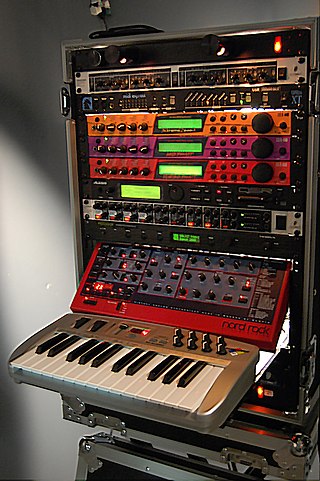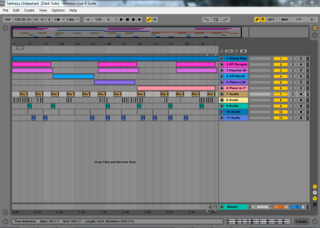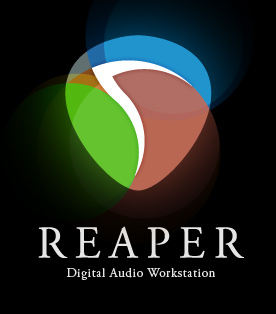Related Research Articles

MIDI is a technical standard that describes a communication protocol, digital interface, and electrical connectors that connect a wide variety of electronic musical instruments, computers, and related audio devices for playing, editing, and recording music.
Ardour is a hard disk recorder and digital audio workstation application that runs on Linux, macOS, FreeBSD and Microsoft Windows. Its primary author is Paul Davis, who was also responsible for the JACK Audio Connection Kit. It is intended as a digital audio workstation suitable for professional use.

FL Studio is a digital audio workstation (DAW) developed by the Belgian company Image-Line. It features a graphical user interface with a pattern-based music sequencer. It is available in four different editions for Microsoft Windows and macOS.
Steinberg Media Technologies GmbH is a German musical software and hardware company based in Hamburg. It develops software for writing, recording, arranging and editing music, most notably Cubase, Nuendo, and Dorico. It also designs audio and MIDI hardware interfaces, controllers, and iOS/Android music apps including Cubasis. Steinberg created several industry standard music technologies including the Virtual Studio Technology (VST) format for plug-ins and the ASIO protocol. Steinberg has been a wholly owned subsidiary of Yamaha since 2005.

Virtual Studio Technology (VST) is an audio plug-in software interface that integrates software synthesizers and effects units into digital audio workstations. VST and similar technologies use digital signal processing to simulate traditional recording studio hardware in software. Thousands of plugins exist, both commercial and freeware, and many audio applications support VST under license from its creator, Steinberg.

Pro Tools is a digital audio workstation (DAW) developed and released by Avid Technology for Microsoft Windows and macOS. It is used for music creation and production, sound for picture and, more generally, sound recording, editing, and mastering processes.

A digital audio workstation is an electronic device or application software used for recording, editing and producing audio files. DAWs come in a wide variety of configurations from a single software program on a laptop, to an integrated stand-alone unit, all the way to a highly complex configuration of numerous components controlled by a central computer. Regardless of configuration, modern DAWs have a central interface that allows the user to alter and mix multiple recordings and tracks into a final produced piece.

In the domain of digital audio, a control surface is a human interface device (HID) which allows the user to control a digital audio workstation or other digital audio application. Generally, a control surface will contain one or more controls that can be assigned to parameters in the software, allowing tactile control of the software. As digital audio software is complex and can play any number of functions in the audio chain, control surfaces can be used to control many aspects of music production, including virtual instruments, samplers, signal processors, mixers, DJ software, and music sequencers.

Novation Digital Music Systems Ltd. is a British musical equipment manufacturer, founded in 1992 by Ian Jannaway and Mark Thompson as Novation Electronic Music Systems. Today the company specializes in MIDI controllers with and without keyboards, both analog and virtual analog performance synthesizers, grid-based performance controllers, and audio interfaces. At present, Novation products are primarily manufactured in China.

Ableton Live is a digital audio workstation for macOS and Windows developed by the German company Ableton.
Digital Performer is a digital audio workstation and music sequencer software package published by Mark of the Unicorn (MOTU) of Cambridge, Massachusetts for the Apple Macintosh and Microsoft Windows platforms.
Avid Audio is an American digital audio technology company. It was founded in 1984 by Peter Gotcher and Evan Brooks. The company began as a project to raise money for the founders' band, selling EPROM chips for drum machines. It is a subsidiary of Avid Technology, and during 2010 the Digidesign brand was phased out. Avid Audio products will continue to be produced and will now carry the Avid brand name.
Logic Pro is a proprietary digital audio workstation (DAW) and MIDI sequencer software application for the macOS platform developed by Apple Inc. It was originally created in the early 1990s as Notator Logic, or Logic, by German software developer C-Lab which later went by Emagic. Apple acquired Emagic in 2002 and renamed Logic to Logic Pro. It was the second most popular DAW – after Ableton Live – according to a survey conducted in 2015.
M-Audio is a business unit of inMusic Brands that designs and markets audio and MIDI interfaces, keyboards and MIDI controllers, synthesizers, loudspeakers, studio monitors, digital DJ systems, microphones, and music software. The company has independent offices in the US, Canada, UK, Germany, France and Japan.
Logic Control is a control surface originally designed by Emagic in cooperation with Mackie.

REAPER is a digital audio workstation, MIDI sequencer and video editing software application created by Cockos. The current version is available for Microsoft Windows, macOS, and Linux. REAPER acts as a host to most industry-standard plug-in formats and can import all commonly used media formats, including video. REAPER and its included plug-ins are available in 32-bit and 64-bit format.

MainStage is a music application developed by Apple Inc. designed for use in live performance.
Harrison Mixbus is a digital audio workstation (DAW) released in 2009, compatible with Microsoft Windows, macOS X, and Linux. It is built on the open-source DAW "Ardour" but includes additional features developed by Harrison Audio Consoles, such as analog-modeled EQ, compression, summing on channel strips, and a master bus with limiter and loudness monitoring tools.

MAGIX Samplitude/ Sequoia is a computer program made by MAGIX for recording, editing, mixing, mastering and outputting audio. The first version was released in 1992 for the Amiga and three years later for Microsoft Windows. The latest versions of the software are Samplitude Pro X5, Samplitude Pro X8 Suite and Sequoia 17. Samplitude is an example of a digital audio workstation (DAW).

AudioCubes are a collection of wireless intelligent light-emitting objects, capable of detecting each other's location, orientation, and user gestures. They were created by Bert Schiettecatte as electronic musical instruments for use by musicians in live performance, sound design, musical composition, and for creating interactive applications in max/msp, pd and C++.
References
- ↑ Thompson, Daniel M. (1 August 2018). Understanding Audio: Getting the Most Out of Your Project or Professional Recording Studio (2nd ed.). Boston, MA: Berklee Press. p. 280. ISBN 978-1-4950-2875-5 . Retrieved 3 January 2019.
- 1 2 Lambert, Mel (2017-11-15). "Taking (DAW) Control". Mixonline. Retrieved 2019-05-16.
- 1 2 3 "Taking Control of Pro Tools with a DAW Controller". Pro Tools Production. 2017-02-16. Retrieved 2019-05-16.
- ↑ HUI - Human User Interface for Digital Audio Workstations - Reference Guide (PDF). USA: Mackie Designs Inc. 1998.
- ↑ "DAW Control | Solid State Logic". Solid State Logic. Retrieved 2019-05-16.
- ↑ McGuire, Sam (17 December 2013). Modern MIDI: Sequencing and Performing Using Traditional and Mobile Tools. Abdingdon, Oxon: Focal Press. p. 62. ISBN 978-0-415-83927-3 . Retrieved 3 January 2019.
- ↑ "PreSonus FaderPort". SoundOnSound. Retrieved 2019-05-16.
- ↑ "Compatible software for Automap: Using Automap for DAW control". Novation. Retrieved 2019-05-16.
- ↑ "The 5 Best DAW Controllers". Home Recording Pro. 2018-03-21. Retrieved 2019-05-16.
- ↑ "Mackie Control". SoundOnSound. Retrieved 2019-05-16.
- ↑ "Ardour Documentation: Devices Using Mackie/Logic Control Protocol" . Retrieved 2020-07-28.
- ↑ Anderton, Craig (2014-03-21). "Article: How to Use Mackie-Compatible Controllers with DAWs". HarmonyCentral. Retrieved 2019-05-16.
- ↑ P, Pieter (2022-04-25). "Control Surface". GitHub . Retrieved 2022-04-25.